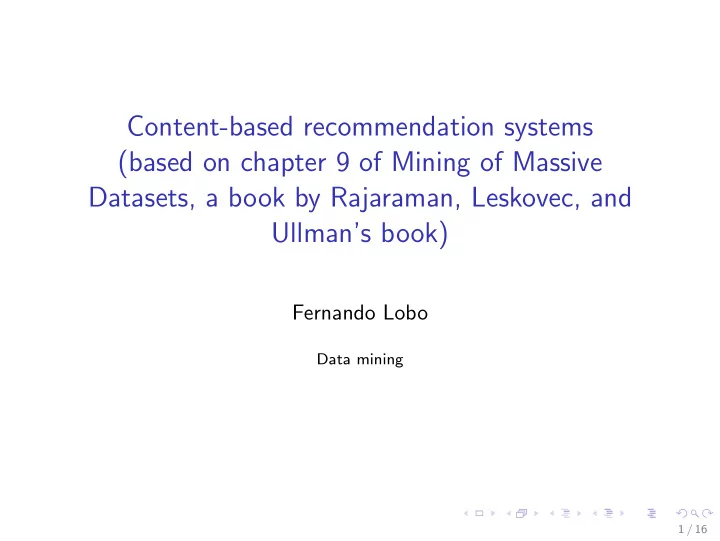

Content-based recommendation systems (based on chapter 9 of Mining of Massive Datasets, a book by Rajaraman, Leskovec, and Ullman’s book) Fernando Lobo Data mining 1 / 16
Content-based Recommendation Systems ◮ Focus on properties of items. ◮ Similarity of items is determined by measuring the similarity in their properties. 2 / 16
Item profiles ◮ Need to construct a profile for each item. ◮ A profile is a collection of important characteristics about the item. ◮ Example for item = movie. Profile can be: ◮ set of actors ◮ director ◮ year the movie was made ◮ genre 3 / 16
Discovering features ◮ Features can be obvious and immediately available (as in the movie example). ◮ But many times they are not. Examples: ◮ document collections ◮ images 4 / 16
Discovering features of documents ◮ Documents can be news articles, blog posts, webpages, research papers, etc. ◮ Identify a set of words that characterize the topic of a document. ◮ Need a way to find the importance of a word in a document. ◮ We can pick the n most important words of that document as the set of words that characterize the document. 5 / 16
Finding the importance of a word in a document Common approach: ◮ Remove stop words — the most common words of a language that tend to say nothing about the topic of a document (examples from english: the, and, of, but, . . . ) ◮ For the remaining words compute their TF.IDF score ◮ TF.IDF stands for Term Frequency times Inverse Document Frequency 6 / 16
TF.IDF score First compute the Term Frequency (TF): ◮ Given a collection of N documents. ◮ Let f ij = number of times word i appears in document j . f ij ◮ Then the term (word) frequency TF ij = max k f kj ◮ Term frequency is f ij normalized by dividing it by the maximum number of occurrences of any term in the same document (excluding stop words) 7 / 16
TF.IDF score Then compute the Inverse Document Frequency (IDF): ◮ IDF for a term (word) is defined as follows. Suppose word i appears in n i of the N documents. ◮ The IDF i = lg( N / n i ) ◮ TF.IDF for term i in document j = TF ij × IDF i 8 / 16
TF.IDF score example ◮ Suppose we have 2 20 = 1048576 documents. Suppose word w appears in 2 10 = 1024 of them. ◮ The IDF w = lg(2 20 / 2 10 ) = 10 ◮ Suppose that in a document k , word w appears one time and the maximum number of occurrences of any word in this document is 20. Then, ◮ TF wk = 1 / 20. ◮ TF.IDF for word w in document k is 1 / 20 × 10 = 1 / 2. 9 / 16
Finding similar items ◮ Find a similar item by using a distance measure. ◮ For documents, two popular distance measures are: ◮ Jaccard distance between sets of words ◮ cosine distance between sets, treated as vectors 10 / 16
Jaccard Similarity and Jaccard Distance of Sets ◮ The Jaccard similarity (SIM) of sets S and T is | S ∩ T | / | S ∪ T | ◮ Example: SIM( S , T ) = 3 / 8 ◮ Jaccard distance of S and T is 1 − SIM( S , T ) 11 / 16
Cosine Distance of sets ◮ Compute the dot product of the sets (treated as vectors) and divide by their Euclidean distance from the origin. ◮ Example: x = [1 , 2 , − 1], y = [2 , 1 , 1] Dot product x . y = 1 · 2 + 2 · 1 + ( − 1) · 1 = 3 Euclidean distance of x to the origin √ 1 2 + 2 2 + ( − 1) 2 = � = 6 (same thing for y ) 3 Cosine distance between x and y = 6 = 1 / 2 √ √ 6 12 / 16
Sets of words as bit vectors ◮ Think of a set of words as a bit vector, one bit position for each possible word ◮ Position has 1 if the word is in the set, and has 0 if not. ◮ Only need to take care of words that exist in both documents. (0’s don’t affect the calculations) 13 / 16
User profiles ◮ Weighted average of rated item profiles ◮ Example: items = movies represented by boolean profiles. Utility matrix has a 1 if the user has seen a movie and is blank otherwise If 20% of the movies that user U likes have Julia Roberts as one of the actors, then user profile for U will have 0.2 in the component for Julia Roberts. 14 / 16
User profiles ◮ If utility matrix is not boolean, e.g., ratings 1–5, then weight the vectors by the utility value and normalize by subtracting the average value for a user. ◮ This way we get negative weights for items with below average ratings, and positive weights for items with above average ratings 15 / 16
Recommending items to users based on content ◮ Compute cosine distance between user’s and item’s vectors ◮ Movie example: ◮ highest recommendations (lowest cosine distance) belong to movies with lots of actors that appear in many of the movies the user likes. 16 / 16
Recommend
More recommend